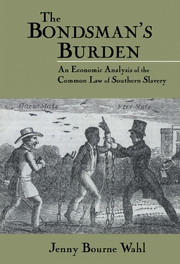Book contents
- Frontmatter
- Contents
- Acknowledgments
- 1 American Slavery and the Path of the Law
- 2 The Law of Sales: Slaves, Animals, and Commodities
- 3 The Law of Hiring and Employment: Slaves, Animals, and Free Persons
- 4 The Law Regarding Common Carriers: Slaves, Animals, Commodities, and Free Persons
- 5 The Law Regarding Governments, Government Officials, Slave Patrollers, and Overseers: Protecting Private Property versus Keeping Public Peace
- 6 The Legal Rights and Responsibilities of Strangers Toward Slaves, Animals, and Free Persons
- 7 Treatment of One's Slaves, Servants, Animals, and Relatives: Legal Boundaries and the Problem of Social Cost
- 8 The South's Law of Slavery: Reflecting the Felt Necessities of the Time
- Notes
- Index
4 - The Law Regarding Common Carriers: Slaves, Animals, Commodities, and Free Persons
Published online by Cambridge University Press: 24 October 2009
- Frontmatter
- Contents
- Acknowledgments
- 1 American Slavery and the Path of the Law
- 2 The Law of Sales: Slaves, Animals, and Commodities
- 3 The Law of Hiring and Employment: Slaves, Animals, and Free Persons
- 4 The Law Regarding Common Carriers: Slaves, Animals, Commodities, and Free Persons
- 5 The Law Regarding Governments, Government Officials, Slave Patrollers, and Overseers: Protecting Private Property versus Keeping Public Peace
- 6 The Legal Rights and Responsibilities of Strangers Toward Slaves, Animals, and Free Persons
- 7 Treatment of One's Slaves, Servants, Animals, and Relatives: Legal Boundaries and the Problem of Social Cost
- 8 The South's Law of Slavery: Reflecting the Felt Necessities of the Time
- Notes
- Index
Summary
Freedom of movement was a hallmark of the young American republic. Slaveowners, like other citizens, could use the burgeoning network of public transportation to their advantage: They profited if they could easily shift slaves from place to place. But common carriers, with all their conveniences, posed perils for the slaveowner. Trains, boats, and stagecoaches caused grievous injuries to slaves as well as offered a convenient means of escape. Faced with these threats to the Southern lifestyle, slaveowners naturally wanted to protect their substantial property interest in other humans. Owners and backers of railroads, stagecoach lines, and shipping concerns were equally intent on preserving capital investments as they extended modern means of transportation throughout the nation. Judges settling disputes between these propertyholders had to reflect on the slave's characteristics as they considered the interests of plaintiff and defendant. At the same time, judges had the unenviable task of applying law generated in a largely rural, agrarian society to controversies involving highly destructive machines wrought by the industrial revolution.
This chapter focuses first on the differences among laws for slaves, commodities, and free persons. It then turns to an analysis of the legal rules governing the carriage of goods and passengers, law regarding train accidents, and rules concerning slave escapes from common carriers. The law established by cases where slaves were injured or killed by common carriers sat squarely between contemporaneous law for free persons and for commodities (especially livestock). Commoncarrier defendants answered for nearly all damages to inert commodities, many injuries to slaves, some injuries to free passengers, and virtually no injuries to other free persons.
- Type
- Chapter
- Information
- The Bondsman's BurdenAn Economic Analysis of the Common Law of Southern Slavery, pp. 78 - 100Publisher: Cambridge University PressPrint publication year: 1997

